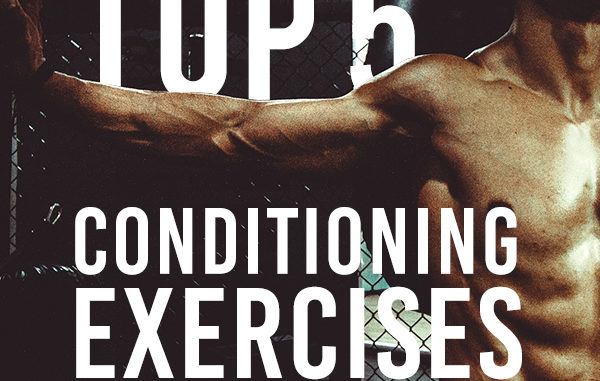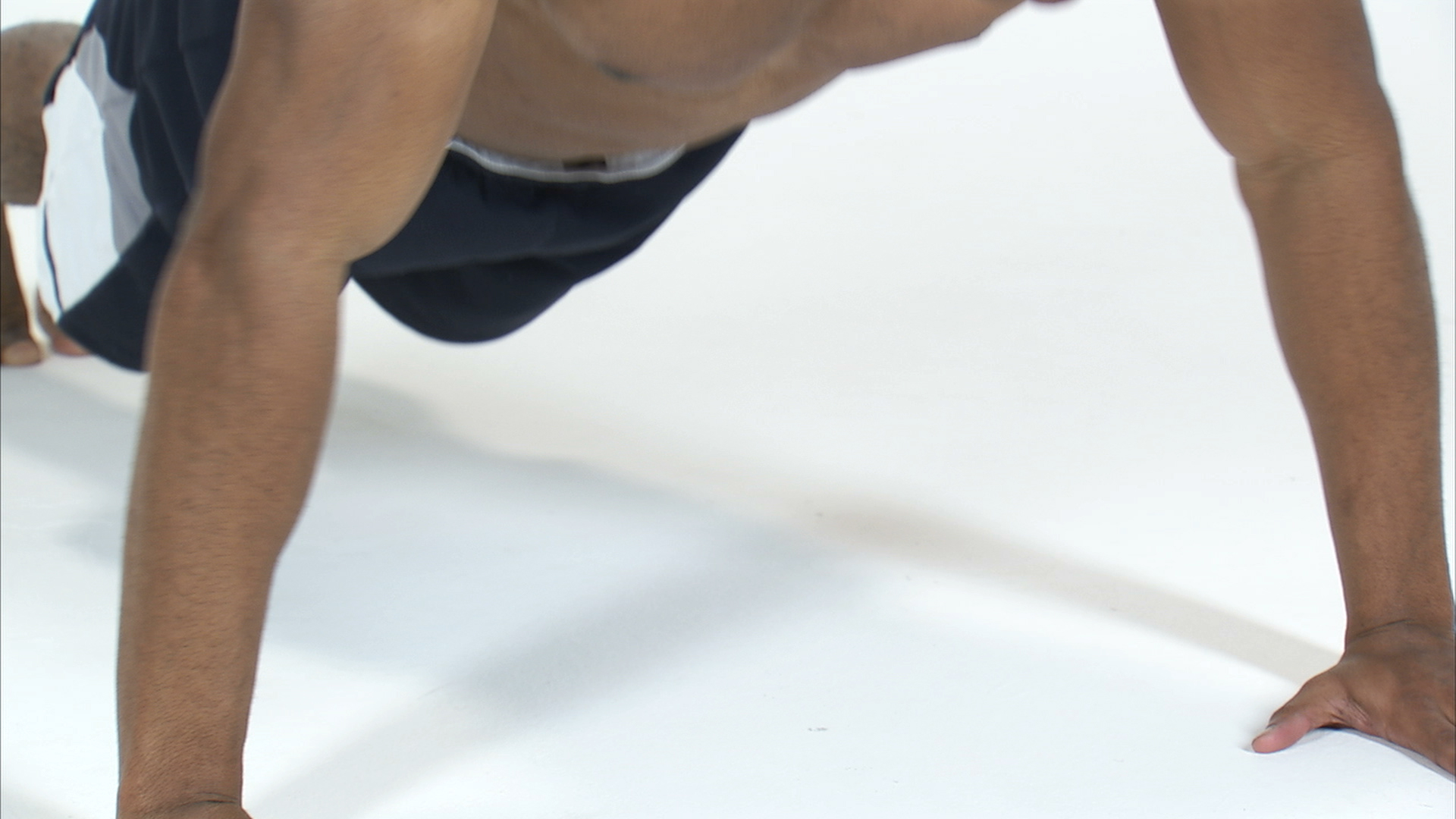
MFTWM knows you don’t have four hours a day to pump iron set after set at the gym. Are you still doing your seated one-arm bicep curls? Bad news, they’re practically a waste of time for the CMP, unless you’re preparing for a bicep flex shot to post on Facebook. Here in MFTWM it’s all about making the most of your valuable time, and we you’re going to get a lot faster and better results doing big, basic body weight exercises than working on any of those ridiculously expensive multi-functional weight training machines or going through a complex routine of endless weight training sets and reps that isolate one then another muscle group.
MFTWM took the liberty of choosing the Top 5 Conditioning Exercises, and arranged them into a hierarchy, meaning ideally go for exercise number one first, and if you have more time in your week go for number two, and henceforth go down the time.
So leave your granny’s abflex in the cupboard and take a gander at the only five exercises you will ever need to keep yourself as fit as a lion:
Top 5: Bridging Roll-ups
(This wicked picture is from http://anthonymychal.com, the site’s got a pretty slick article on bridges.)
Bridging, the wrestling kind. You’re only as strong as your weakest link and bridging will strengthen all those little muscles groups with names most people probably wouldn’t recognize in the neck and torso but are so important for building no non-sense core strength. This will translate to a lot more power in wrestling or grappling. There’s another surprising good benefit from strengthening your neck which is hot news for all you strikers. Having a strong neck keeps your head stable when you get tagged by heavy punches and kicks and other power bombs to your head and thus reducing the how much your brain gets whipped about, keeping you from being rocked, knocked out and reducing the possibility of injuries your could get to your main noodle (brain).
Do take care if you have never done wrestling bridges before or haven’t done so in a long time. Try it first using your hands for support, no shame in that. BCF! Start slowly and give your neck some time to get used to the exercise before supporting your full body weight with just your head.
Here’s a winner’s tip: for bridges, a full range of motion will do loads of good. When you do the wrestler’s bridge try make your nose touch the mat. When doing reps with side to side movements of the head, try make your ears touch the mat.
Top 4: Jump squats
Jump squats are a 100% natural, no non-sense exercise for building explosive jaguar-like leg power. Jump squats also exercise a full range of motion. If jump squats have a funny effect on your knees, go for Hindu or regular squats. Jump squats, and it’s other squat exercise cousins will also be excellent for strengthening your lower back as you’ll quickly find out if your aren’t familiar with these exercise, excellent for keeping your core stable for those swift power moves. Excellent for your keeping your double-leg take down ferociously strong.
Squeeze in some good family bonding by asking your little child (or big one better) to hang on your back or carry them lying down in your arms when you do your jump squats. It’s great bonding and will be fun work out for junior too.
No fancy equipment needed, just an application of sheer explosive power rep after rep.
Winner’s tip: go for a full extension of your legs, powering through the entire jumping motion.
Top 3: Pushups
Yeah, that’s it push-ups, just like what they do in the army, but maybe even more wicked. You can do it the old fashion way, and then feel free to try out variations to this age old exercise: arms wide apart, clip wings, diamond, one-handed, inclined, knuckle push-ups and so on.
Having to stay at home on Sunday shouldn’t necessarily mean you can’t have a monster chest, shoulders and arms work out. Have your spouse sit on your shoulders either to the side or your head between her legs or your child cling your on to your back while you do push-ups. Aside from the extra weight which will help build strength, having to cope with this shifting, uneven weight will force a lot more stabilizer muscles into action.
Top 2: Pull-ups
My all-time favorite, pull-ups. Great exercise, lots of variations: hands shoulder with, close grip, wide grip, palms facing out, palms facing in, one palm facing in the other out. Each set will blast your back. No single exercise will build your upper body strength faster.
Can’t do a single pull up? Don’t be embarrassed, trust me, quite a lot of adults can’t. Start out just hanging on the bar. When that’s easy cheesy try budging upwards a little more each time. Keep at it till you can do one pullup, even if you have to swing and kick your legs. And when you can do one, do one every day and the rest will be history till you build your cobra-wide back.
No place to do pull-ups? Depending on your individual circumstance the biggest challenge for some to doing pull-up is finding a place to do them. As a kid I used to do them all the time on a fire-escape ladder for a couple of years which hung from the second story window down over the front door). Luckily for those who don’t have access to a pull up bar, or doing pull-ups or trying to do pull-ups in full view of the public isn’t your thing, you can buy yourself this wickedly simple little ingenious contraption which I personally recommend and which should put you to shame if you find any excuse not to include pull-ups in your daily or at least weekly exercise routine.
Winner’s tip: go for what they call the scapular hang. At the end of the pull up hang-down low enough so that your scapula, that flat bone on your back where your arm is attached, also spreads out.
Pull-ups: simply the king of upper body exercises. Enuf’ said.
Top 1: Running
Nothin’ beats the great grand daddy of all exercises: running. Running always has and always will play a valuable role in fitness. Man has evolved to cover long distances and your inner saber-toothed tiger hunting hunter-gather is itching to run. And if there’s one physical quality which will be an advantage to your game, it’s going to be cardiovascular endurance. If the conditions are right, and you could only choose one exercise, it should be running.
For the CMP it is a great idea to incorporate bursts of speed or intervals into your running routine. Finding time for a long steady run can be challenging with all the work and family responsibilities you have to juggle around. If you can only allot a short time to running it’s best to string together a couple of hard sprints rather than one long low-intensity jog. Just because you have to stop often to catch your breath often doesn’t mean you aren’t doing it right. On the contrary, it just means you pushed your body to the limit which is the end goal of your exercise. In fact, because running comes so naturally to man, running is actually an exercise easy to overdo if you haven’t done any serious running in long time. Start out slow, maybe not more than a couple hundred of meters around the block if it’s the first time. Then over a period of weeks, crank up the intensity and distance of your runs.
For me, the most absolutely most important thing for running is that it should be made enjoyable, and if should be done outdoors if possible, and while you’re at it bring along the spouse, kids and family dog.
So there it is – MFTWM’s hierarchy of the top 5 conditioning exercise. There’s no reason not to start. Keep fit, keep happy, keep on top of your game.



A few years ago I had read a really interesting article in Black Belt Magazine called “Build Martial Arts Muscle” by Matt K. Elam. I provide a link to it at the end of my comment. In this article Mr. Elam discusses sarcolemic (aka myofibrillar) hypertrophy, sarcoplasmic hypertrophy, the differences between the two and the different ways either type can benefit a martial artist. He suggests a “minimalist approach” to working out (as you do) and outlines a routine using all bodyweight exercises (again, as you do here). I think you’ll like what you’ll read in that article. It’s that good.
2nd thing I want to point out (for the benefit of my fellow CMPs) is a bodyweight exercise routine that is called Power/Strength Contrast Training. This routine can also be done with weights if one chooses but I’ve only done it using bodyweight exercises as that is my preference as a practicing Martial Artist. With this routine one would start out by doing 5 to 10 reps of an EXPLOSIVE exercise then immediately do a STRENGTH movement that works the same plane of movement. An example with push ups would be to do one set of plyometric or “clap” push ups for 5 to 10 reps and then immediately do one set of regular push ups stopping just short of failure. With squats, one would do a set of jump squats followed by a set of regular bodyweight squats. With this routine there is no break between the explosive exercise and the regular exercise. You do the explosive movement and then IMMEDIATELY do the regular exercise afterwards. THAT IS ONE SET. I like this routine because it addresses both areas of power that are needed to be good at MMA, that is explosive power for striking and relative strength for grappling.
Lastly concerning the wrestlers bridge; this is a great time proven exercise. A variation that I like to do is the “Upa” escape drill that is taught to all beginners in Judo and Brazilian Jiu Jitsu. I also like doing regular “bird dog” bridges but with weight. Why? Because it develops explosiveness in your bottom escapes which is absolutely essential! The Upa/Bridge can be used to explosively escape every basic bottom position. And it’s a gross motor move to boot. 😀
Sorry for my long windedness. 🙂 and for my frequency of commenting. It’s just that I really do enjoy this website and hope that it gets more exposure and becomes more popular. It’s a unique niche in the online MMA community and one that specifically resonates with me and my current lifestyle as a CMP.
Here’s the link to the article I spoke of at the beginning of my comment.
Take care,
Damon.
https://archive.org/details/Black_Belt_March_2015/page/n62